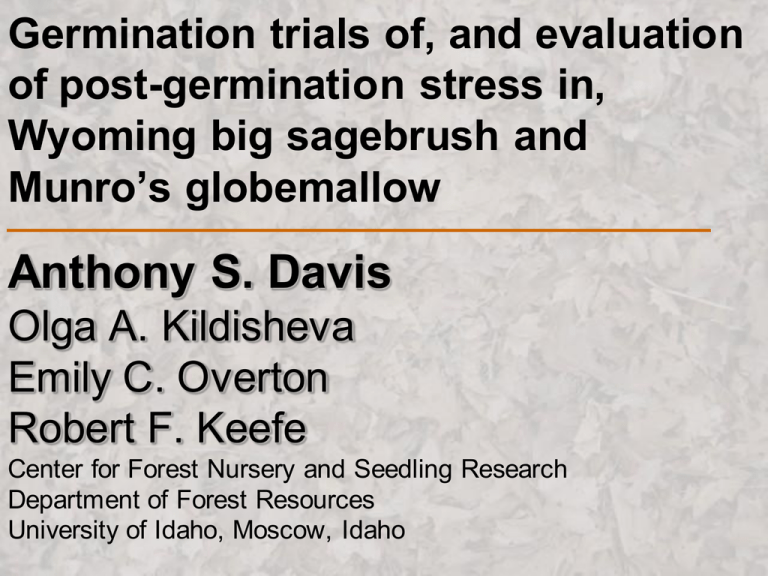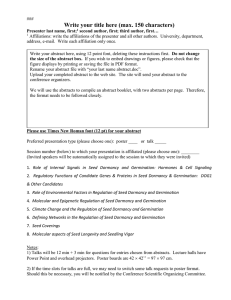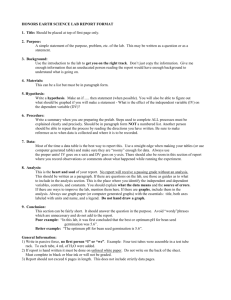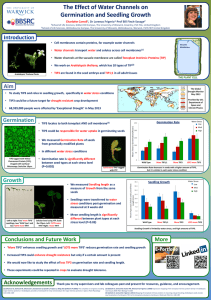Germination trials of, and evaluation of post-germination stress in, Munro’s globemallow
advertisement

Germination trials of, and evaluation of post-germination stress in, Wyoming big sagebrush and Munro’s globemallow Anthony S. Davis Olga A. Kildisheva Emily C. Overton Robert F. Keefe Center for Forest Nursery and Seedling Research Department of Forest Resources University of Idaho, Moscow, Idaho Overview • Background – Center for Forest Nursery and Seedling Research • Seedling quality • Restoration ecology • Nursery production • Research plan – Munro‟s globemallow – Wyoming big sagebrush • The Native Plant Network About me • Assistant Professor Department of Forest Resources – Research • Optimizing seedling production • Native plant regeneration – Teaching • Forest regeneration (core course) ‘getting the right plant in the right place’ • Director Center for Forest Nursery and Seedling Research – Operate Pitkin Forest Nursery – 3.5 full time and ~20 part time employees Seedling quality • What is a quality seedling? – Quality: “superiority in kind” – Must be defined within constraints • • • • • • “Fitness for purpose” Environmental Cost Ownership objectives Silvicultural practices Biological • A quality seedling is one which is likely to meet its desired performance upon outplanting Seedling quality • Influenced by – Genetic composition – Size – Seedling vigor (nursery culture) – Environmental conditions – Storage, planting, and handling The “target plant concept” Vision • Regional, national, and international leader – Native plant regeneration • Education • Scholarship • Valued partner with native plant growers and users Center for Forest Nursery and Seedling Research Facilities • Franklin H. Pitkin Forest Nursery – Produces up to 400,000 seedlings (~70 species) annually – ~2 miles from University of Idaho main campus – On-site research laboratory Lab facilities • Plant environmental stress research • Seedling gas exchange • Controlled environments • Temperature, pH, moisture meters, sensors, probes Cold hardiness • Surrogate measure of dormancy status • Predict ability to withstand stress of lifting, storage, and planting – Indicator of performance potential – Indicator of stress resistance (Fuchigami et al. 1992) Seed quality • Computer model to predict seed germination as a function of seed morphology – Optimizing uniformity of germination rate • Use of digital X-ray for rapid seed quality assessment (supported by Faxitron Corp.) • Use of digital X-ray and marked seed for precision seed cleaning and grading Digital X-ray and scan Arrowleaf balsamroot Fernleaf biscuitroot Oregon grape Overcoming seed dormancy in Munro‟s globemallow Overall research objectives • Develop protocol for overcoming dormancy in S. munroana • Assess early life development of seedlings under a variety of modified environmental conditions (e.g., moisture regimes and CO₂ levels) Preliminary trials • Identify the effects of scarification on imbibition and germination – Seeds soaked for 24 and 48 hours – ½ of the seeds pierced prior to soaking • Increased germination in pierced seed would indicate physical dormancy – Test the “whitebark pine scarifier” for effectiveness • Seeds placed in the scarifier for 0, 1, 10, or 15 minutes • No soaking occurred following scarification. Soaking/piercing results 30 # germinants 24 hours 25 Soaking/piercing Trial 20 % germination 24 hr soak 20 24 hr soak, pierced 52.5 48 hr soak 2.5 15 10 5 0 8/10/2009 24 hours, pierced Treatment 48 hours 65 48 hrs, 48 hr soak, pierced 8/15/2009 8/20/2009 8/25/2009 8/30/2009 9/4/2009 9/9/2009 pierced Scarification results # germinants 30 Scarification Trial control 25 Treatment 15 Control 10 1 minute 5 10 minutes 0 9/19/2009159/24/2009 9/29/2009 minutes 10 % germination minutes 20 10/4/2009 16.8 1 minute 17.6 15 20.8 minutes 10/9/2009 9.6 10/14/2009 Potential of pelletizing to aid in germination and establishment • Used in sowing of crop species with small or irregularly shaped seeds • Makes seed heavier and more uniform in shape • Formed by tumbling seeds, while an adhesive and an inert binding material are added – Appropriate pellet thickness – Optimum adhesive and binding materials Potential of „priming‟ seed to improve germination success • Priming seed is another option that may improve germination and establishment using direct seeding • Osmo-priming, using polyethylene glycol (PEG), hydrates seed to a point where germination beings but radicle emergence does not occur • Priming allows for more uniform germination under suboptimal temperatures and possibly other environmental stressors The Native Plant Network • Online home of Native Plants Journal • Native Plant Propagation Protocols Database – User-uploaded protocols – Searchable – Over 2500 protocols www.nativeplantnetwork.org Leveraging • Idaho Transportation Department – Fully funding a graduate student • University of Idaho Seed Grant* Program – Additional research equipment *may have been awarded on humor of applying for a seed project







